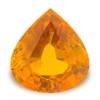Glittering Stones » Gemstone Research Centers » Gemological Institute of America(GIA)
ABOUT GIA:
"I refer to GIA as the custodian par excellence of standards and integrity in our business. . ."
GARY RALFE
Managing Director
De Beers Group
The Gemological Institute of America, or GIA, is a non-profit institute dedicated to research and education in the field of gemology. GIA is also well known for its gem identification and grading services, and developed the famous "four Cs"; (Cut, Clarity, Color and Carat weight) methodology of grading diamonds.Although GIA is best known for its activities in relation to diamonds, the institute is also involved with colored gemstones and pearls. The educational arm of GIA confers the Graduate Gemologist diploma upon its graduates; the institute also offers other diploma programs.GIA was founded in 1931 by Robert Shipley in Los Angeles, California. Today, the institute is headquartered in Carlsbad, California, north of San Diego.
WHAT IS GIA?A TRADITION OF SCIENCE AND EDUCATIONEstablished in 1931, the Gemological Institute of America is the world’s foremost authority on diamonds, colored stones, and pearls. Ensuring the Public Trust A nonprofit institute, GIA's mission is to ensure the public trust in gems and jewelry by upholding the highest standards of integrity, academics, science, and professionalism through education, research, laboratory services, and instrument development. GIA attained its leadership role through decades of integrity and ingenuity, and everything we do is still driven by this mission. A Place of Learning GIA is where students from all over the world build successful careers in the gem and jewelry field. The Graduate Gemologist (G.G.) diploma, which focuses on gem grading and identification, is the industry’s highest professional credential. And with its Graduate Jeweler, Applied Jewelry Arts, and Accredited Jewelry Professional programs, GIA offers training geared to every aspect of the industry. A Place of Breakthrough Discoveries GIA is the global leader in gemological research, and its findings serve to protect the consumer. Using sophisticated technology, Institute researchers analyze thousands of samples each year. When new synthetic gems and artificial enhancement processes enter the marketplace, GIA is there to detect them. A Place to Turn to for Unbiased Analysis of Gemstone Quality GIA is the world’s most respected gemological laboratory, entrusted with grading and identifying more gems than any other lab including the Hope, the Taylor-Burton, the De Beers Millennium Star, and the Incomparable.Located in major gem and jewelry centers around the world, GIA laboratories are staffed by expert diamond graders and gemologists, whose work sets the standard for grading practices worldwide. A Tradition of Discovery and Innovation Since the 1930s, GIA researchers have made numerous breakthrough contributions to our understanding of gems. These milestones include: building the first gemological microscope with darkfield illumination, a revolutionary technique in which the gem appears bright and vivid against a dark background (1938) creating the D-to-Z color scale and Flawless-to-I3 clarity scale for diamonds (1953), internationally recognized standards for evaluating diamond quality detecting irradiated yellow diamonds (1956) determining the color of black cultured pearls to be natural (1961) the first study of a new gem now known as tanzanite (1968) the first report on faceted synthetic diamonds (1971) identifying glass-filled rubies (1984) detecting fracture-filled diamonds (1989, 1994) evaluating the durability of emerald filling substances (1991) distinguishing natural from synthetic diamonds (1995) detecting synthetic moissanite, a popular diamond imitation (1997) identifying the effect of fluorescence on diamond appearance (1997) detecting diamonds decolorized by high pressure/high temperature (HPHT) treatment (1999) detecting gem-quality synthetic diamonds created by chemical vapor deposition (CVD) (2003) creating a comprehensive system for grading diamond cut quality (2004) |
WHY GIA RESEARCH?For decades, GIA has been on the cutting edge of gemological research, analyzing data on gems and their characteristics. This effort becomes more challenging each year, as new gem sources emerge and new treatment processes and synthetic materials come onto the market. A gem’s geographic origin affects its market value, and consumers also want to know that their gemstones come from ethical sources. And if artificially enhanced gems and synthetics were left undetected, every gem and jewelry purchase would be a risk. GIA is dedicated to providing consumers the knowledge they need, and that’s why research is at the very core of GIA’s nonprofit mission. |
SERVICES:GIA provides diamond grading services to describe the characteristics of loose diamonds. GIA issues two types of reports, the more complete being the Diamond. Grading Report (a briefer and less expensive version is called a Diamond Dossier). The Diamond Grading Report identifies the key characteristics of a diamond which can be used to both identify the diamond and determine its value. The reports contain a number of measurements, including of carat weight as well as a diagram of where and what types of inclusions are located in the diamond. Diamond grading reports are now demanded by most consumers purchasing diamonds over a certain size, typically for over 0.5 carat (100 mg), and almost always for over 1.0 carat (200 mg), and are considered an important tool in guaranteeing that a diamond is accurately represented to a potential buyer. |
Competitors:GIA has several competitors in providing diamond grading reports and gemology training: |
CONTACT:Contact GIA : 800-421-7250 Internationalb : 760-603-4000 Fax : 760-603-4080 Email : marketing@gia.edu <marketing@gia.edu> |
NOVEMBER BIRTHSTONE - CITRINE

COMMEMORATIVE EVENT - 13th Anniversary
KEYWORDS - Success, Abundance, Personal Power
ALSO KNOWN AS - Merchant's stone, Success stone
COLORS - Pale yellow to brown
OCCURRENCE - Brazil
COLOR ZONING - Tiger stripes or Zebra stripes


